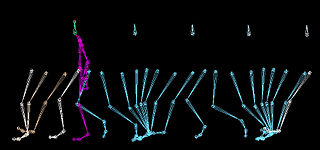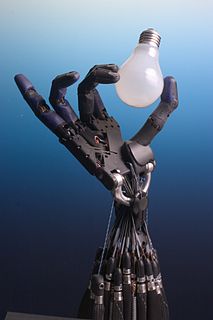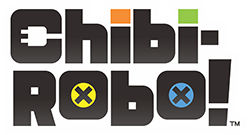
Walking is one of the main gaits of locomotion among legged animals. Walking is typically slower than running and other gaits. Walking is defined by an 'inverted pendulum' gait in which the body vaults over the stiff limb or limbs with each step. This applies regardless of the unusable number of limbs—even arthropods, with six, eight or more limbs, walk.
Robot locomotion is the collective name for the various methods that robots use to transport themselves from place to place.
Roboraptor is a robotic toy invented by Mark Tilden in 1999, and then distributed by Wow Wee Toys International. It is the successor to the RoboSapien robot and uses motion technology based on realistic biomechanics that give it fluid and natural movements. It has a multi-function remote control that uses infrared technology to talk to it. Unlike the original RoboSapien, the Roboraptor is capable of autonomous movement, using 3 realistic gaits.
RoboCup Junior (RCJ), sometimes stylised RobocupJunior, is a division of RoboCup, a not-for-profit robotics organisation. It focuses on education and aims to introduce the larger goals of the RoboCup project to primary and secondary school aged children. Participants compete in one of three main leagues: Soccer, Rescue or Dance. Dance Theatre also exists as a sub-league of Dance, and Premier Rescue is part of the competition in Australia.
Robot software is the set of coded commands or instructions that tell a mechanical device and electronic system, known together as a robot, what tasks to perform. Robot software is used to perform autonomous tasks. Many software systems and frameworks have been proposed to make programming robots easier.

Custom Robo is a sci-fi action role playing game. It was released in 1999 for the Nintendo 64 only in Japan, and in 2006 for the iQue Player only in China. It is the first title of the Custom Robo series.
The Robopet is a robotic dog produced by WowWee that is based on the biomorphic work of Mark W. Tilden. The Robopet has IR, audio and tilt sensors and is able to wander around autonomously detecting and reacting to objects and sounds. It also performs random 'tricks' such as howling, begging, rolling over and playing dead.
FemiSapien is a female humanoid robot that WowWee announced at CES in January 2008. It can respond to sight, sound, and touch and can be programmed with a sequence of movements. At CES 2008 an estimated release date of late summer and $99 MSRP were given, and was being sold for $89.99 in 2009.

Robotics is an interdisciplinary branch of engineering and science that includes mechanical engineering, electronic engineering, information engineering, computer science, and others. Robotics deals with the design, construction, operation, and use of robots, as well as computer systems for their control, sensory feedback, and information processing.

RoboRally is a board game originally published in 1994 by Wizards of the Coast (WotC). It was designed in 1985 by Richard Garfield, who would later create the card game Magic: The Gathering. The game and its expansions received a total of four Origins Awards. RoboRally was rereleased in July 2005 under the Avalon Hill label, and again in 2016 by Wizards of the Coast.

Rayman 2: The Great Escape is an action-adventure video game developed by Ubi Pictures and published by Ubi Soft and the sequel to Rayman. It was released for the Nintendo 64 and Microsoft Windows in 1999, and Dreamcast and PlayStation in 2000. It was adapted for the PlayStation 2 as Rayman Revolution, the Game Boy Color as Rayman 2 Forever, the Nintendo DS as Rayman DS, and as Rayman 3D on the Nintendo 3DS.

The Amazing Spider-Man is an action-adventure video game, based on the Marvel Comics character Spider-Man, and the 2012 film of the same name. It was developed by Beenox and published by Activision. It was released on June 26 in North America and on June 29, 2012 in Europe, for Nintendo DS, PlayStation 3, Xbox 360, Wii, Android, iOS, and Microsoft Windows. A version for the Wii U was released March 5, 2013 in North America and March 8, 2013 in Europe as The Amazing Spider-Man: Ultimate Edition in both regions. in Spring 2013, the PlayStation Vita version was released in November 2013.
The Samsung Galaxy Express (GT-I8730) is a smartphone made by Samsung which was launched in March 2013 in India featuring a similar design to the Galaxy S Duos but with additional features such as 4G LTE, NFC. It also features a bigger 4.5-inch screen with Super AMOLED Plus and retains all the features which the Samsung Galaxy S III phone has.

RoboBee is a tiny robot capable of partially untethered flight, developed by a research robotics team at Harvard University. The culmination of twelve years of research, RoboBee solved two key technical challenges of micro-robotics. Engineers invented a process inspired by pop-up books that allowed them to build on a sub-millimeter scale precisely and efficiently. To achieve flight, they created artificial muscles capable of beating the wings 120 times per second.
Kirobo is Japan's first robot astronaut, developed by University of Tokyo and Tomotaka Takahashi, to accompany Koichi Wakata, the first Japanese commander of the International Space Station. Kirobo arrived on the ISS on August 10, 2013 on JAXA's H-II Transfer Vehicle Kounotori 4, an unmanned resupply spacecraft launched August 4, 2013 from Japan's Tanegashima Space Center. A twin to Kirobo, named Mirata, was created with the same characteristics. Mirata will stay on Earth as a backup crew member. The word "kirobo" itself is a portmanteau of "kibō" (希望), which means "hope" in Japanese, and the word "robo" (ロボ), used as a generic short word for any robot.

Atlas is a bipedal humanoid robot primarily developed by the American robotics company Boston Dynamics, with funding and oversight from the U.S. Defense Advanced Research Projects Agency (DARPA). The 1.8-meter (6 ft) robot is designed for a variety of search and rescue tasks, and was unveiled to the public on July 11, 2013.

Chibi-Robo! is a series of platform video games developed by Skip Ltd. and published by Nintendo.
"RoboCop" is a song by American hip hop artist Kanye West, from his fourth studio album 808s & Heartbreak. It was produced solely by West and contains background vocals from Tony Williams and Jeff Bhasker. "Kissing in the Rain" by Patrick Doyle is sampled in the song, which references the film RoboCop and West's ex Alexis Phifer.











